The Little Things We Love about Spain (And What Drives Us Crazy)
Now that we’ve been in Spain and Portugal for a month and a half, we’ve had a chance to putter around several different cities and towns, and get a feel for life here.
It’s the small details of life in a new place that really fascinate me. I love to find out how the locals live. Where they shop, what they eat, how they get around…
What have we found in Spain?
It’s laid back. Spain very much lives up to the stereotype that life here is slower, and people are much more relaxed about time.
Happily, this leaves a lot of time for leisurely enjoying gelato in the outdoor plazas and coffees at small cafes. In our month in Spain, I have only seen one person walking around with a to go coffee cup. And that was someone leaving the snack bar beside a gas station.

Ah, speaking of coffee… mmmm. I’m a bit of a coffee snob. In fact, the phrase drip coffee maker makes me simultaneously angry and twitch involuntarily (I’m sure Charles is rolling his eyes about now). While Italy is famous for its espresso, I’d have to say that Spain’s simple cups of coffee are a solidly respectable brew. In fact, it took almost a month, and coffees at probably over 20 cafes, before I finally tasted my first bad cup of coffee.
Moka pot espresso makers. Luckily, it’s rare to find a drip coffee maker in Spain. Instead, we’ve found moka pot makers everywhere. You put water in the lower chamber, coffee in a basket above, and then heat it on the stove top. As the water boils, it passes though the compressed coffee grounds, and up into the upper chamber. These stove top espresso machines make a great cup of Joe.
Where’s the fridge? You’d be forgiven for thinking that kitchens in Spain don’t have fridges. Not only do the fridge doors match the cupboards, the fridges are usually tucked away in the bottom cupboards. The fridge in our last house in Canada was a stainless steel, three-door, six foot, side by side 25 cubic foot monstrosity. It was always packed full. The fridges in our rental houses in Spain are barely bigger than a bar fridge in Canada.
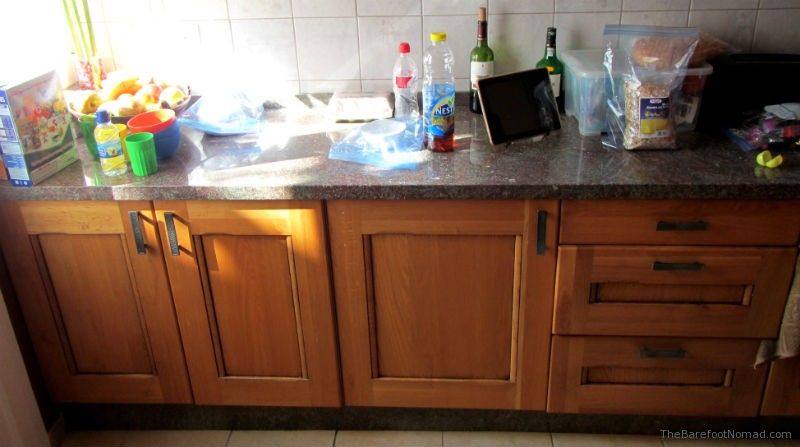
People shop almost every day. Probably because their fridges are so tiny. Honestly, I think this is probably better, as you get exercise walking to the store, and your fruit and veggies are fresher.
Why is there a washing machine in the kitchen? And where’s the dryer? This is probably due to space constraints, as we’ve found apartments to be much smaller than in Canada. What did surprise me was that we haven’t even been able to find a dryer in Spain. Every place we’ve rented comes with a drying rack and clothes pins, and usually a place to hang clothes outside. Which brings me to:
Is that a grandma’s underwear waving around on the balcony? Because there are so few dryers, and many apartments are so small, you’ll see people hanging all manner of things to dry on their balcony. This is how I know that most men in Spain wear briefs, and fewer wear boxers.
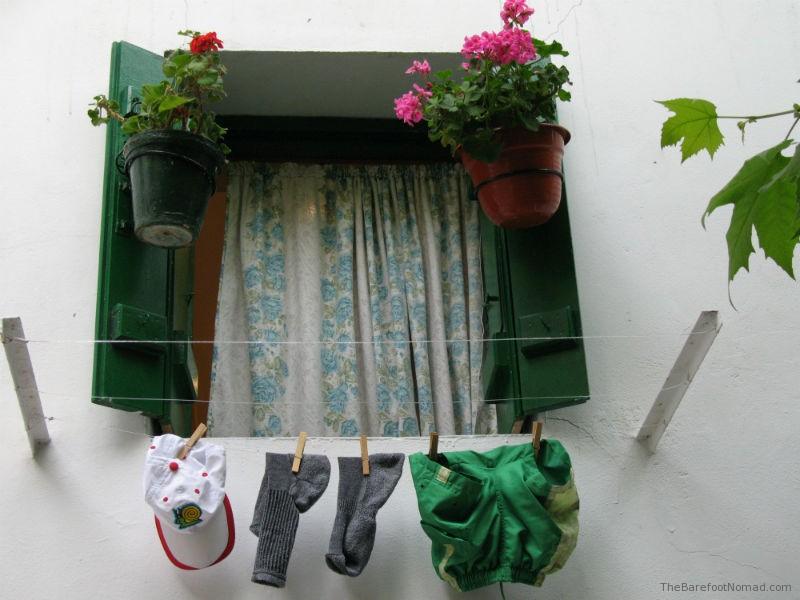
Leisurely meals. Not only do meals start late, but you’re allowed to linger as long as you like. In North America, it’s very common to get the check before you ask and sometimes well before you’re done eating. You’re also expected to finish up and leave in a timely manner once your meal has been consumed. In Spain, even in the busiest of restaurants, we’ve always had to ask for the check and it’s common for people to linger hours after their meal is finished.
Little kids stay up late, too. As we were finishing up a very late meal after checking out a night festival in Nerja, a table of about ten little Spanish kids (with four frazzled looking adults in tow) sat down beside us. It was well past 10 pm at one of our favorite restaurants in Nerja and more families were waiting in line as we left. In Spain, the typical family sits down to eat supper anywhere from 8 to 11 each night.
You really don’t need a car. In Madrid, we walked almost everywhere, and took the metro for longer trips. Even small towns can be managed quite well without a car. We’re staying on the outskirts of Nerja, a town of about 20,000 people in Southern Spain, close to Almuñécar and Malaga, and are managing quite well without our own transportation. Even in this small town, there’s a local bus that circles the town every hour, and buses that connect Nerja with almost anywhere in Spain. There’s a small supermarket seemingly every half dozen blocks, and a taxi home runs about 6 Euro.
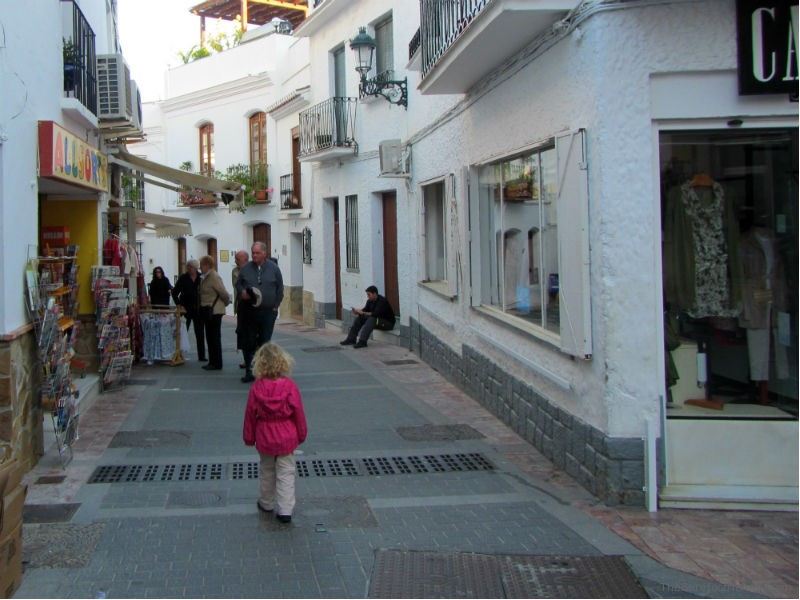
Fresh produce. The sunny climate in the South means that Spain can grow fresh veggies year round. When we arrived in February, we found ripe, delicious strawberries from Andalucia in every grocery store in Madrid. These sweet, naturally ripened beauties were a world away from the rock-hard, half green hydroponically grown monstrosities that we get in Canada in the winter. Tomatoes here taste like tomatoes off the vine, ripened slowly in the sun.
Cheap alcohol. A typical bottle of wine in Canada runs between $10 $15 to dollars a bottle with a few of the cheaper varieties going as low as $7 or $8 on sale. In Spain you can pick up a variety of brands for a Euro or two. A can of decent beer can be had here for 30 cents. Don’t even ask what beer goes for in Canada. Even in restaurants alcohol is often only a dollar or $2 a glass and is often cheaper than juice and about on par with soft drinks. Since we’re not driving most of the time, we’ve definitely been drinking alcohol more often than we did back in Canada.
Free appetizers with alcohol. Spain loves its tapas. Around here it’s very popular to go on a tapas crawl. Most bars, pubs and restaurants include a free appetizer when you order a glass of wine or a beer. With cheap alcohol in abundance, a lot of people wander from place to place ordering a drink here and a drink there while tasting tons of local gastronomical delights called tapas. From fresh bread and cheese to plates of olives, fish or meat some places feature a dozen different tapas every day. Depending on the place you can choose your own or they can choose it for you. If you stumble onto a place with something so amazing that you want more of it you can usually order a full or half ration (called a racion in Spanish) and gobble away.
Long life milk and whipping cream. We found milk and even whipped cream in Spain alongside the fruit juice on supermarket shelves. It’s pasteurized and treated so it stays good for months at a time and doesn’t need to refrigerated until it’s opened. You can still buy fresh milk in the dairy section at many supermarkets, but we’ve found the long life milk to be pretty convenient. Plus, many of the brands taste virtually the same as fresh milk.
Now, all this love of Spain doesn’t mean there aren’t a few things that still puzzle us, or drive us a bit crazy.
Where’s the oatmeal? You can buy ready-made granola (made mostly of oats) anywhere, but we had to hit up a specialty import store to find oatmeal for breakfast. The same goes for a lot of foods that we take for granted back home such as syrup, vanilla or anything Mexican.
Dog poop. What’s up with all of the dog business on the sidewalks? We’ve got our little ones trained to dodge the sidewalk surprises now, but, trust me, that was a hard-learned lesson.
The hunt for contact lens solution. In Canada, we can buy solution for our lenses anywhere from gas stations to supermarkets to convenience stores. Not so in Spain. After not being able to find solution in either grocery stores or pharmacies, we tracked some down (at a fairly hefty price) in an optical store. The very patient Spaniard at the optical counter managed to make me understand, in a combination of English and Spanish, that it was law in Spain that lens solution could only be sold at certain places.
Specialty stores. Like the comment above, many things that you could buy in one big place back in North America you have to hit 4 or 5 stores in Spain. Specialty shops are the norm here and running out to pick up a few varied things can sometimes be a half days adventure trying to figure out where to go to get everything on your list. We love supporting small mom and pop operations however sometimes it’s nice to be able to get it all under one roof.
Siesta Time. Generally, we’re all for taking a nap in the afternoon. Especially when the days are warm and the evenings are long. The problem here is that most stores and even a lot of restaurants close down for a few hours between 2 and 5:30 PM each day. We’re not crack of dawn type travelers and even then we generally work and do schoolwork most mornings. More often than not afternoons are our time to get out, see the sites and run errands. The fact that we don’t have a car and can’t stockpile food like we used to means that we always pick up food on our way home. Having to kill an hour with the kids every other day because the store is still closed for siesta gets annoying after the tenth or twentieth time.
Have you been to Spain? Did you find anything that you loved (or that drove you crazy)?
Did you find that even in Spain’s larger cities like Madrid and Barcelona, there’s a respect for leisure and fun?
We’d love to hear about it!
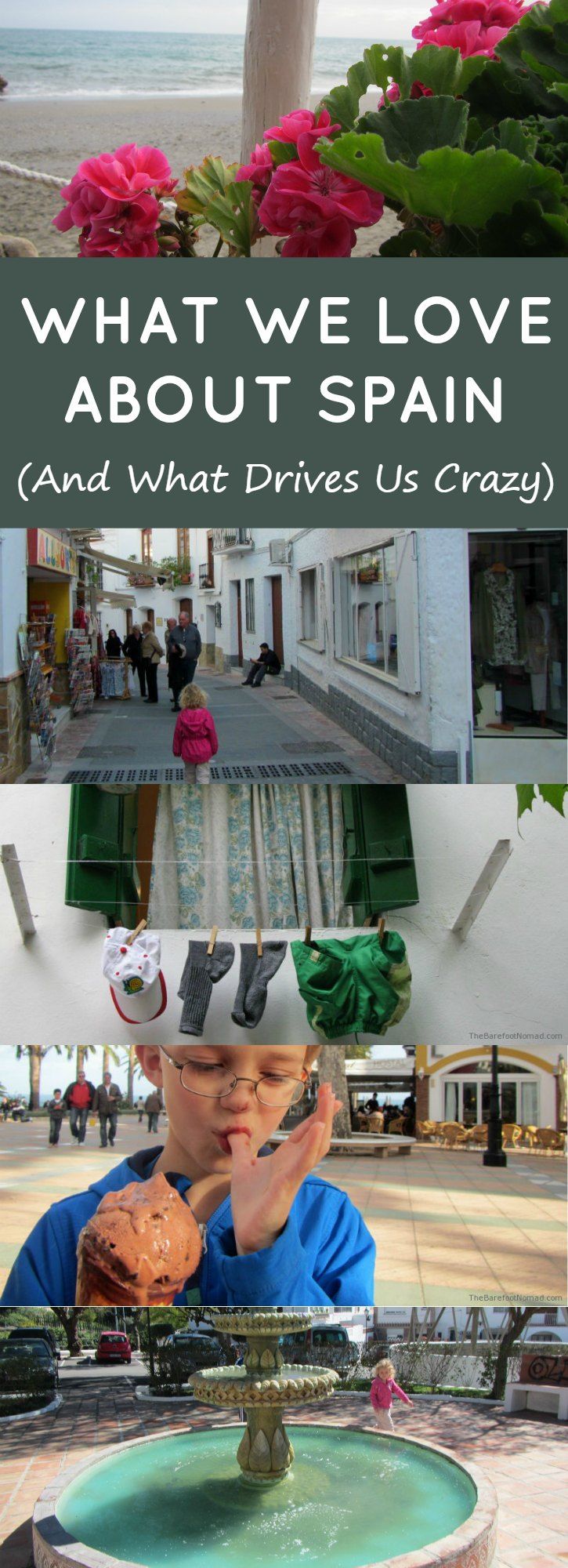

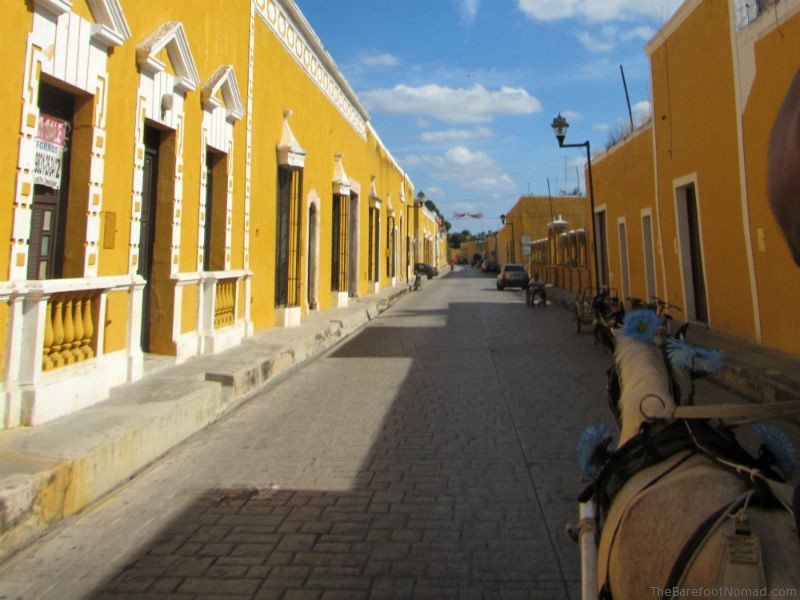
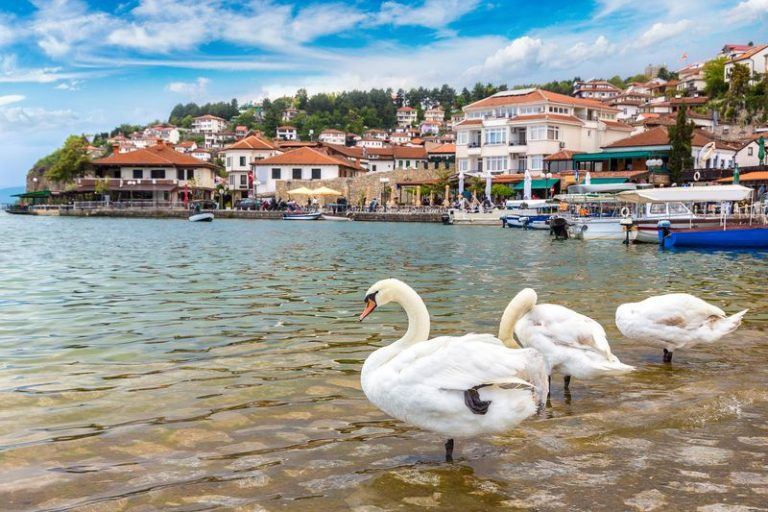
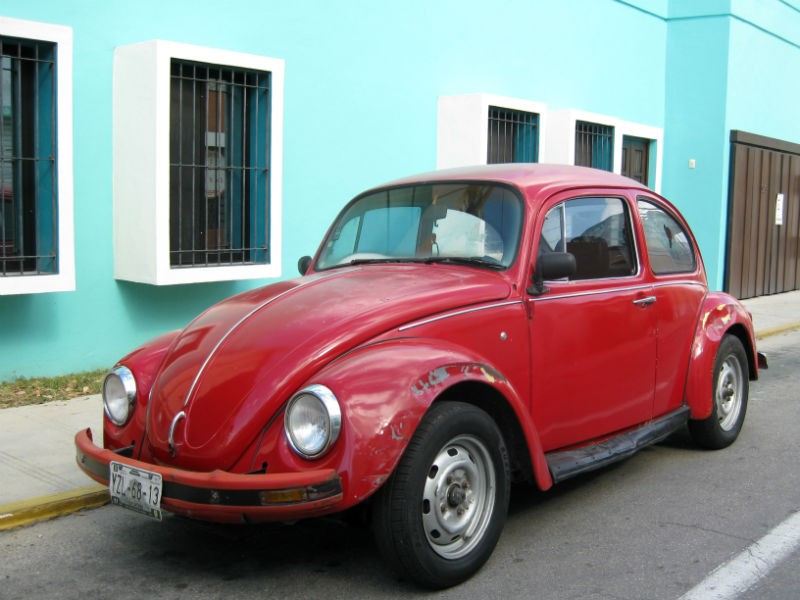

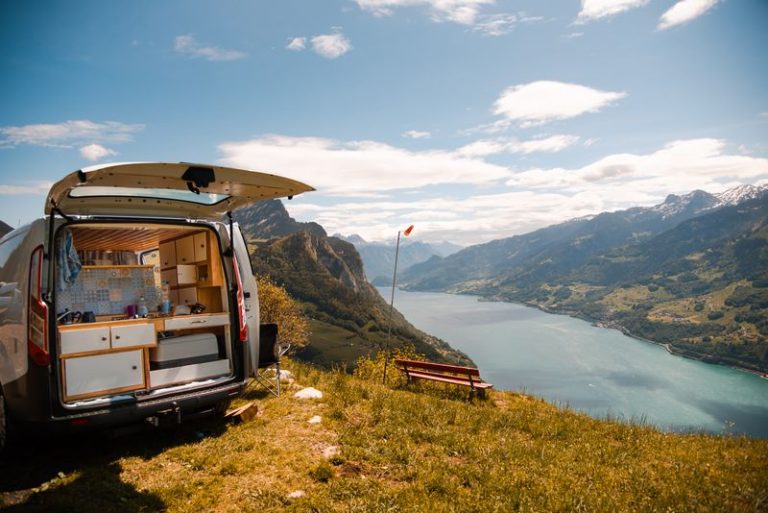

Hey Micki,
You nailed it with the “gotcha’s” for me. Those same things drive me crazy! I love how friendly people are and that when you meet someone you get the double cheek kisses. As you know we aren’t far from Nerja and out little town takes so much pride in keeping the streets clean (excluding the dog poop). That has to be the biggest “make my skin crawl/get on my nerves” thing. Life is simple and pleasant. You captured it well. I am so glad you guys had time to take it slow in Spain and that we were able to meet up.
Hi Heidi,
I haven’t had any of the double cheek kisses. I’m a bit worried about that, as I’ve had quite a few Dutch colleagues (who do the triple cheek kiss) or French friends (who do the single cheek kiss). Odds are, I’m going to misjudge the Spanish double cheek kiss and land a big wet one on the lips of some poor person. 🙂
hey micki…i loved your article and also meeting your great family. I am now back in the states and I have been mentioning exactly everything you have in your article! Also, it’s a little confusing at first switching the decimals with the commas and the elevator in my hotel was just big enough for two people with perhaps one very small bag. Another thing I didn’t realize at first was one must weigh their produce and label their produce before going to the checkout. Quite an experience but I love every moment and hope to go back this November.
Hi Beverly, Thanks so much for stopping by to check out our site! We loved meeting up with you the other day. I’m still getting used to having someone else weight the produce. We did find one store (Mercadonna) where we weigh the produce ourselves, but they make you put on disposable plastic gloves before you pick out your produce. Our kids thought that was the most fun – they insisted on bringing the plastic gloves home. 🙂
We just could not deal with dinner at 9:00 PM at the earliest. In the Costa del Sol town of Torremolinos which even tries to cater to British tourists, it was really hard to actually have dinner any earlier than that. We came across a restaurant that opened at 7:30 PM for dinner one evening.I ordered the roast chicken. The waiter looked at me like I was from Mars, rolled his eyes and informed me that obviously the roast chicken was not finished cooking yet.
Pero, me encanta Espana. I love Spain and I’m sure if we had our own cooking facilities we could have managed just fine with just the occasional dinner out.
This article definitely cracks me up. After living in Spain for over five years, I’ve learned to deal with the lack of a dryer (send my jeans to my mother-in-law!), the dog poop (they say it’s lucky to step in it) and American food items. I do, however, live next to the Alcampo in town, which has one-stop-shopping and great prices!
We were in a tiny Andalucian village where the one and only tiny supermarket had a few set opening hours in the morning and evening, but some days they would just not open up, so we would have to hang around or keep on running back to check every 15 minutes to see if they were open, or just decide we would do without.
I loved the way the village people and I had long conversations, waiting for our turn at the Bakers Van, them in Spanish and me in English, with lots of Si, Si’s and smiles. I loved the way everything came to us – the organic egg lady rang the door bell twice, the vege man pulled up at the park, the baker came twice a day blasting his horn and I never did find the fish man.
Most of all I loved the attitude and friendliness of the people.
I came to Spain 1983 for a two-week vacation, and I’m still here. I’ve got Spanish husband, two sons, wonderful fulfilling work, as well as a dryer and large fridge. I thought the article was quite good and indicative of open-minded travelers willing to delve into local culture. I have been to Nerja on many occasions and it was great to see the photos – It is worth mentioning that there are scores cf expats living in Spain who have never bothered to learn the language or attempt to absorb and enjoy the local culture, but it’s their loss.
Kristy, Thanks so much for the kind words. Yes, I always find it sad when expats don’t make an effort to learn the local language and culture. I find that at least making an effort at the local language and customs is really appreciated, and often breaks through a lot of barriers 🙂
You made me remember of Argentina in 80% of what you lived there 🙂
Lorena, Oh that’s so interesting. I assumed that most of these were true for the rest of Europe. We’ve never been to Argentina, but would absolutely love to go!
I really didn’t care for Spain until we got to Granada, which I fell in love with. That was the Spain I had been hoping for!
I really didn’t have any gripes with that part of Spain, unlike Madrid. It was hard to remember I needed to do the shopping early or very late in the day. And eating out for a late lunch was next to impossible because of siesta. But I got in the groove. 🙂
Talon, we really fell in love with Spain when we got to Andalusia. I’m still trying to adjust to stores being closed from 2-5 everyday. Though I do love the late nights and sleeping in!
ah, the coffee. Yes. Well, you made me want to go visit!
I am a coffee snob too. I live in the US now and it is hard to find good coffee.
I am originally from Spain and we never had a tiny fridge or the washing machine in the kitchen. I did though, when I lived in Dublin. The apartment was so tiny there!
I had been coming to Spain off and on since 1978 and finally moved here permanently last year. My wife and I live in Rota Cadiz. We moved here for the quality of life. I was tired of having to drive everywhere to get anything done when living in the U.S. I like being able to walk to the butcher, baker and candlestick maker. The one negative thing I can say about Rota is that it is a lot more expensive than other nearby towns; almost double the cost for anything except food. And even then you have to shop around. There are so many positives; Everyone lives near the beach because the entire town is surrounded by beaches; Most of the people are friendly; Having an american base located here helps keep the local economy from completely crashing; Local buses run frequently; Seafood!! Oh, and they just put in a McDonald’s! Some see this as a negative. However, with 26% unemployment, Spain needs all the help they can get.
The lack of a freezer used to annoy me about living in England (because they have the mini-fridges and not fridge/freezers), but at least I ate less ice-cream!
This post illustrates both the joys and frustrations of travel. . . but in the end I think places aren’t better or worse–just different.
Ultimately the differences make me appreciate the benefits of the new place while fondly remembering the comforts of home.
Thanks for capturing the essence of the feeling 🙂
Your comment about the kitchen washing machine reminded me of the ghastly washer/dryer combo I had in my apartment when I lived in London. Didn’t perform either task very well, but it did save space.
Love the way the gelato all but leaps off the page, btw. Nice post.
Great post! That coffee pot sounds like the old perk one my mom had. Drip coffee makers didn’t exist until the 1970s. Everyone made coffee the old fashioned way. Washers in the kitchen and small fridges are really common in Europe. I love shopping daily at specialty markets.
Love this post and this is my new GO TO quote: “An immaculate house is a sure sign of a wasted life.” I hope you don’t mind but it will now become the tag line of my life 🙂
Hello Micki! I live in Poland and some of your observations would be adecuate also for my country, for example such as fridges hidden in cupboards or long life milk. Other things you mentioned in your article also attract our attention every time we are in Spain. We love Spanish way of life and adapt to it with pleasure while on holidays.
Very interesting insight. The contact lens solution thing is crazy! Was just Spain last month, and I could totally see myself living there. Guess there are pros and cons everywhere.
Can anyone help me with info on the English language schools in Torreviejo and in Spain, in general? Do most students go to language school AFTER regular daily school? I found this to be true in my stay in S.Korea, as well. Or do students learn English in private and public daily schools? Does anyone have any experience with these private schools having worked there or sent children there for instruction? I am interested in working at a private school in Torreviejo. Any insight you can give into work and life in Spain as an expat would be greatly appreciated. Thanks! Mellie-middle aged single teacher form NC, USA. looking to live/work abroad!
Hi Melie. Our kids never went to school while we were in Spain so we really don’t know how it works however I can point you to two blogs that would know something about it.
Cat from Sunshine and Siestas moved there from the US a few years back and teaches English in Seville. She would definitely know a thing or two about English schools.
You can also check out our friends, the Wagoners who have moved to Spain and decided to put their kids into regular Spanish school. They talk a fair bit about the education system on their site Wagoners Abroad and might know a thing about English in the schools as well.
Hope that helps. Good luck!
Aaaaaw The two things I like the most from Spain are its food and siesta time, absolutely! So I recommend you Andalucia. Have you ever been there? If you go someday, you should rent out an apartment in Sevilla, Granada or Malaga . You’ll have an incredible experience as I had, for sure ^^